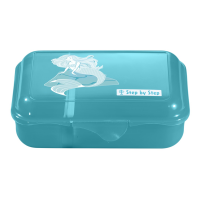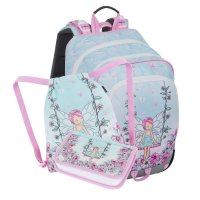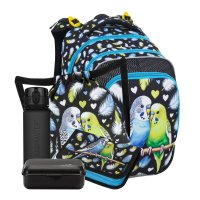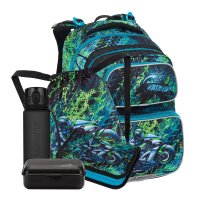Summer adventures are slowly coming to an end, the days are getting shorter, and there's a special mix of nostalgia and anticipation in the air. Yes, September is approaching, and with it, school. For many parents, this means one thing: the start of a marathon of preparations, writing endless lists, and a whirlwind of questions in their heads. What will my first grader need? Did we forget something important for the older student? And how on earth do I choose the right school backpack so it doesn't cause back pain?
Take a deep breath. You're in the right place. At Bagalio, we understand your worries, which is why we've prepared the most detailed complete guide to school gear you can imagine. We'll walk you through the entire process step by step, from A to Z. With our tips, checklists, and advice, you'll manage the preparation for the new school year without unnecessary stress and with the confidence that your child will be missing absolutely nothing at their desk. Let's work together to make the start of the new school year successful and joyful.
Contents
- The Cornerstone of Gear – School Backpack or Satchel?
- Pencil Case and What Must Be Inside?
- Notebooks, Covers, and Folders – How to Keep Learning Organized
- Mandatory "Side" Gear for a First Grader
- Equipment for Special Subjects and Clubs
- Frequently Asked Questions When Buying School Gear for 1st Grade
- Ready for a Successful School Year!
The Cornerstone of Gear – School Backpack or Satchel?
Before we even start listing writing supplies and notebooks, we must focus on the most important thing – the school backpack or satchel. It is often seen as just a practical accessory, but its role is absolutely key. It is an investment in your child's health and comfort for the next several years. A poorly chosen, non-ergonomic backpack can cause back pain, neck pain, poor posture, and overall fatigue. Therefore, choosing the right one should be your number one priority.
On the market, you will encounter two basic types: the classic school satchel with a rigid structure and the modern school backpack. What is the difference between them, and which one is right for your child?
| Feature | School Satchel | School Backpack |
| Construction | Rigid, stable, often single-compartment, holds its shape. | Softer, more flexible, multiple compartments and pockets. |
| Ideal for | First graders and primary school students (approx. 1st and 2nd grade). | Older students (from approx. 3rd grade), middle and high school students. |
| Advantages | Perfect organization, contents are protected, stands stably on the ground, making it easy to handle. | Adapts better to the body, offers more designs, grows with the child, also suitable for clubs and trips. |
| Disadvantages | Can be heavier, less flexible for carrying bulkier items. | Without good internal organization, it can lead to clutter; softer construction protects contents less. |
What to Focus on When Choosing and How to Select a Satchel/Backpack for 1st Grade
Whether your heart leans towards a satchel or a backpack, always keep these five key parameters in mind. They define a truly high-quality and safe school backpack that will be a support, not a burden.
-
Anatomically Shaped and Breathable Back: The foundation is a healthy back. The back panel of the backpack must perfectly follow the natural curve of the spine and provide it with firm but comfortable support. Look for backpacks with certification confirming their ergonomic properties. Equally important is high-quality padding with ventilation channels to prevent unnecessary sweating.
-
Adjustable Straps are a Must: Forget backpacks with fixed straps. Look for wide (at least 4 cm), softly padded, and smoothly adjustable shoulder straps. An absolute standard to demand is also a chest strap. It ensures that the backpack does not slip off the shoulders and fits better on the body. For backpacks not just for older children, a hip belt is a huge benefit, helping to transfer up to half the weight from the shoulders to the more stable pelvic area.
-
Low Weight and Adequate Volume: The golden rule is: an empty backpack for a first grader should not weigh more than 1200 grams, and for older children, up to 1400 grams. The total weight of a filled backpack should not exceed 10–15% of the child's body weight. Therefore, carefully consider what your child carries daily and leave unnecessary weight at school.
-
Reflective Elements: Safety first. In our climate, where it is dim in the morning and gets dark early in the afternoon for much of the school year, plenty of reflective elements are an absolute must. They must be placed on all sides of the backpack – front, sides, and on the shoulder straps.
-
Quality Material and Precise Workmanship: Even the best backpack is useless if it starts to fall apart after a few months. Pay attention to strong seams, durable and easy-to-use zippers (ideally with large pull tabs for small children's hands), and material with a waterproof treatment or an integrated rain cover. A sturdy bottom will protect the contents of the backpack from moisture and dirt.
Tip: We discuss how to choose a suitable school bag in detail in a separate article in our guide section.
Pencil Case and What Must Be Inside?
A school pencil case is a little kingdom for every student and their personal business card. A properly and completely equipped pencil case is a basic prerequisite for successfully doing homework, drawing, drafting, and overall well-being during lessons. While the equipment for a first grader is often specified in detail by the school, you have a freer hand with older children. We have prepared a universal list for you that you can't go wrong with.
Checklist for First Graders and Younger Students (Primary School): Pencils, Crayons, and Other Supplies
- Fountain Pen: Usually acquired in the second half of the 1st grade. Choose an ergonomic pen with a triangular grip and a quality nib (ideally iridium) that adapts to a child's writing. Also consider a rollerball or ceramic pen.
- No. 2 Pencils (HB hardness): At least 2–3 pieces. Thicker, triangular pencils are ideal as they support a correct grip and fingers do not slip.
- Quality Sharpener: It must sharpen well and not break the lead. A closed one with a container for shavings is ideal.
- Soft Eraser: Get a quality eraser that erases well, doesn't smudge, and doesn't damage the paper.
- Crayons: A set of at least 12 basic colors. Here too, thick triangular crayons are the best choice for young children to practice correct grip.
- Short Ruler (ideally 15 cm) that fits in the pencil case.
- Scissors with rounded tips: Safety first.
- Glue stick: Small, compact.
Tip: For younger children, single- or multi-level pencil cases with elastic loops are ideal. Everything has its place and is perfectly organized. Older students often prefer a simple pouch (etui), which is more compact and holds more items "loosely".
Notebooks, Covers, and Folders – How to Keep Learning Organized
A flood of notebooks, textbooks, and worksheets can quickly lead to complete chaos in a backpack. Crumpled corners, spilled pages, and the endless search for the right notebook before class are a nightmare for both children and parents. Proper organization of school supplies is half the battle.
Most schools provide a list of required notebooks with specific numbers at the beginning of the year. These numbers define the format (A5, A4) and the type of ruling (lined, squared, plain). A great way to teach a child to be organized is through a color-coding system. Get folders, covers, and even notebooks in colors that the child can associate with a specific subject (e.g., green for science, blue for language arts, red for math). Navigation in the backpack and on the desk will then be much faster and more intuitive. Don't underestimate sturdy folders for notebooks (with an elastic band or snap) and durable covers for textbooks. They will protect them from damage and extend their lifespan.
Tip: In our category of school backpack accessories, you will find, among other things, practical organizers that make it easier for young students to organize school notebooks, papers, and textbooks directly in their satchel or school backpack. Some of these organizers can be removed from the bag and hung on a hook next to the desk.
Mandatory "Side" Gear for a First Grader
A school day is not just about sitting at a desk and learning. For a child to feel good, be full of energy, and safe, it's necessary to think about a few other, seemingly secondary, but absolutely essential accessories.
- Lunch box and water bottle: A healthy snack and staying hydrated are absolutely key to maintaining energy and concentration throughout the morning. Forget plastic bags and PET bottles. Invest in a high-quality, well-sealing lunch box, ideally with separate compartments, and a non-toxic water bottle. Look for products made from certified BPA-free materials (e.g., Tritan or stainless steel) that do not release harmful substances.
- Indoor shoes: Comfort and hygiene in the classroom are important. Most schools require indoor shoes with a firm heel (not slippers), a light and non-marking sole, and made of a breathable material to prevent children's feet from sweating unnecessarily.
- Bag for gym shoes or clothes: A fabric bag is ideal. It is lightweight, breathable (sweaty clothes won't get musty in it), and fits easily into a backpack or school locker.
- Wallet and keychain: Even young children learn responsibility. A small wallet for change for lunch or pocket money and a keychain with a key to a locker or home are practical helpers.
Equipment for Special Subjects and Clubs
We've covered the basic school equipment, but what about subjects that require special supplies?
- Art class: This list is usually the longest. Everything is usually stored in a practical art case. What should be in it? Tempera and watercolor paints, a set of flat and round brushes, a water cup (ideally non-spill), a palette, a cloth, wax crayons, colored papers, scissors, glue, modeling clay, a rubber mat for the desk, and an old shirt or apron to protect clothing.
But before you start shopping, wait for the teacher's instructions. Supplies are often purchased in bulk for the class. - Physical education: The basis is suitable sportswear and footwear. Usually, a student needs two pairs of shoes – one with a light-colored sole for the gym and another, more durable pair, for the outdoor playground. Additionally, a T-shirt, shorts/leggings, and a tracksuit for colder weather. Everything should again be stored in a breathable bag.
Frequently Asked Questions When Buying School Gear for 1st Grade
- What school supplies does a first grader need?
A first grader needs basic school supplies like a satchel, pencil case, notebooks, pencils, crayons, and art supplies. They should also have a gym bag, a lunch box, and a water bottle for daily school activities. - How to choose a satchel for a first grader?
Choosing a satchel is important for your child's comfort and health. It should be ergonomically designed, of sufficient size, and lightweight. It's also a good idea to choose a model with reflective elements for greater safety on the way to school. - What are the art supply needs for a first grader?
For art class, a first grader needs watercolors, tempera paints, brushes, a plastic desk mat, scissors with rounded tips, and paper. An art case is also practical for storing these supplies.
Tip: Each school approaches art supplies differently; some schools, for example, set up a fund from which art supplies are then purchased in bulk. We therefore recommend waiting until September to buy them, when the teacher will tell you what the students will need. - Where to buy a school satchel and other supplies?
You can buy a school satchel and other supplies in physical stores selling luggage or stationery, or online. It's a good idea to compare prices and choose from different brands to find the best option for your child.
Tip: At Bagalio, you can get a satchel, school backpack, lunch box, water bottle, gym bag, folders, and many other school supplies for your child. We also offer practical school sets, which are usually more cost-effective and also contain components in the same design! - What kind of pencil case to choose for a first grader?
The ideal pencil case for first graders is a single-level one, with enough loops to store crayons and pencils. It should also be lightweight and easy to open, so the child can easily find their things.
Ready for a Successful School Year!
You did it! You've gone through our entire guide and now you have all the information you need to give your child the best start to the new school year.
Now you know what no student should be without. We wish you the best of luck with your choices and a successful, relaxed, and joyful school year full of new knowledge and friendships for your children. And if you want to get almost everything for school in one place, explore our offer at Bagalio.eu, where you'll find everything you need of the highest quality.












